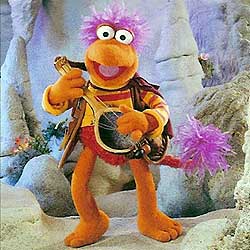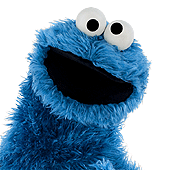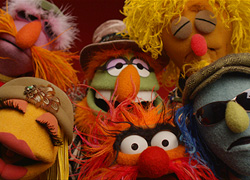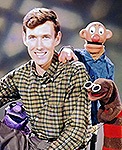More first episode morsels:
Gordon and Anything Muppets
The Anything People were later renamed Anything Muppets.
The first two Anything Muppets in this sketch were performed by Frank Oz -- one on each hand!
Many Sesame Street sketches have taken place in front of a plain-colored background, often with a brick wall for the Muppets to be behind.
During the first season, a dark white colored background was often used. Later on, more colors would be added, including blue, green, and purple.
The mother Anythign Muppet was performed by Caroll Spinney. During the first season, it was common for Caroll Spinney to perform characters besides Big Bird and Oscar, but eventually, he would pretty much just stick to the bird and the grouch.
Caroll Spinney later created and performed a garbage man named Bruno the Trashman, whose main purpose was to carry Oscar in his trash can. The arms were usually attached to the can, allowing Spinney to perform Oscar through a hidden opening while inside the Bruno suit. Bruno rarely spoke.
The last two anything Muppets in this sketch were performed by Jim Henson.
The Anything Muppets were used for various characters, including regular characters. Each pattern had a specific name, including Fat Blue, Hot Pink (the small pink anything muppet), Oraneg Gold (used for characters sucha s Guy Smiley and Don Music), and Pumpkin (used for the tall orange anything muppet).
This scene originally ended witht eh cast singing Consider Yourself. Unfortunately, that is not included here, due to music rights.
Mr. Hooper was played by Will Lee. Unlike the other human cast members, Will Lee had previous acting experience, though he was blacklisted and had trouble finding work for a long time.
Will Lee had known James Earl Jones before the series began, and James Earl Jones became the first celebrity hired for the show. Jones appeared in sketches that appeared in the test pilots, but his scenes weren't broadcast untill the second episode.
Song of 2
During the first season, Sesame Street only taught kids to count up to 10. However, the number 1 did not sponsor the show untill the 1980s.
Despite this, there were skits for the number 1, many of which appeared in episodes that were sponsored by 2.
All of these segments ended with a baker falling down the stairs. Because of this, fans have often referred to them as "The Baker Films".
During the first season, the entire street set was presented as one straight area. Beginning in the secodn season, a curve was added in the courtyard, which got bigger and expanded to include a tire swing and a stairway.
Although this episode is sponsored by the numbers 2 and 3, only 2 has multiple skits in this episode.
Jazz #2
The singer in this series of skits was Grace Slick, of Jefferson Airplane.
These skits are titled "Jazz", but due to the presence of spies, many fans have referred to them as "The Jazzy Spies".
Skits for the numbers 2 through 10 were produced during the first season.
During the first season, Ernie wore a purple and orange stripped shirt, instead of a red and blue stripped shirt.
There are two types of Muppets: ones with arms controled by rods, and ones controlled by having performers put their hand sinside of them, also known as "Live Hand Puppets".
Bert is a rod-controlled puppet, whiel Ernie is a live-hand puppet.
Usually, the performer of the character performs the head, body, voice, and left arm, while another performer usually performs the right arm.
Like how Sesame Workshop was originally called he Children's Television Workshop, Jim Henson's company has changed it's name many times. It was originally called Muppets, Inc, and then it became Henson Associates, then Jim Henson productions, and currently, The Jim Henson Company.
Bob is played by Bob McGraph, and he and Loretta Long are the only original human cast members still involved with the show.
In this scene, Bob says that he's a shop teacher, but later on, he would become a music teacher.
Matt Robinson, who played Gordon, was originally just going to be a producer on the show, but eventually he got the role of Gordon as well.
Eventually, he would get to perform the voice of a Muppet named Roosevelt Franklin, while Loretta Long would play Roosevelt Franklin's mother.
Buddy and Jim
Buddy and Jim were a comedy duo who only appeared on the show during the first season.
Buddy was played by Brandon Maggart. Jim was played by James Catusi.
In the second season, they would be replaced by Larry and Phyllis, who would then be replaced by Ralph and Wally in the third season.
Many of Buddy and Jims segments would be remade by Wally and Ralph.
Apparantly, human comedy duos on Sesame Street don't last long, while Muppet comedy duos, such as Ernie and Bert or Biff and Sully, have lasted.
The popularity of Sesame Street would lead to many international versions, many of which are different from eahc other.
Sesame Street has also led to many television specials, albums, live shows, books, and two full-lenght movies.
Two of the most profitable toys based on Sesame Street characters have been Tickle Me Elmo and Sing 'n Snore Ernie.

 Welcome to the Muppet Central Forum!
Welcome to the Muppet Central Forum! Back to the Rock Season 2
Back to the Rock Season 2 Sesame Street Season 54
Sesame Street Season 54 The Muppets Mayhem premieres
The Muppets Mayhem premieres Bear arrives on Disney+
Bear arrives on Disney+ Sam and Friends Book
Sam and Friends Book